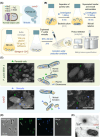Leveraging Engineered Pseudomonas putida Minicells for Bioconversion of Organic Acids into Short-Chain Methyl Ketones
- PMID: 39748701
- PMCID: PMC11744930
- DOI: 10.1021/acssynbio.4c00700
Leveraging Engineered Pseudomonas putida Minicells for Bioconversion of Organic Acids into Short-Chain Methyl Ketones
Abstract
Methyl ketones, key building blocks widely used in diverse industrial applications, largely depend on oil-derived chemical methods for their production. Here, we investigated biobased production alternatives for short-chain ketones, adapting the solvent-tolerant soil bacterium Pseudomonas putida as a host for ketone biosynthesis either by whole-cell biocatalysis or using engineered minicells, chromosome-free bacterial vesicles. Organic acids (acetate, propanoate and butanoate) were selected as the main carbon substrate to drive the biosynthesis of acetone, butanone and 2-pentanone. Pathway optimization identified efficient enzyme variants from Clostridium acetobutylicum and Escherichia coli, tested with both constitutive and inducible expression of the cognate genes. By implementing these optimized pathways in P. putida minicells, which can be prepared through a simple three-step purification protocol, the feedstock was converted into the target short-chain methyl ketones. These results highlight the value of combining morphology and pathway engineering of noncanonical bacterial hosts to establish alternative bioprocesses for toxic chemicals that are difficult to produce by conventional approaches.
Keywords: 2-pentanone; Pseudomonas putida; acetone; butanone; ketones; metabolic engineering; minicells; synthetic biology.
Conflict of interest statement
The authors declare no competing financial interest.
Figures





Similar articles
-
Growth-coupled bioconversion of levulinic acid to butanone.Metab Eng. 2019 Sep;55:92-101. doi: 10.1016/j.ymben.2019.06.003. Epub 2019 Jun 19. Metab Eng. 2019. PMID: 31226347 Free PMC article.
-
Efficient bioconversion of raspberry ketone in Escherichia coli using fatty acids feedstocks.Microb Cell Fact. 2021 Mar 12;20(1):68. doi: 10.1186/s12934-021-01551-0. Microb Cell Fact. 2021. PMID: 33706766 Free PMC article.
-
De novo production of the monoterpenoid geranic acid by metabolically engineered Pseudomonas putida.Microb Cell Fact. 2014 Dec 4;13:170. doi: 10.1186/s12934-014-0170-8. Microb Cell Fact. 2014. PMID: 25471523 Free PMC article.
-
Pseudomonas putida as a functional chassis for industrial biocatalysis: From native biochemistry to trans-metabolism.Metab Eng. 2018 Nov;50:142-155. doi: 10.1016/j.ymben.2018.05.005. Epub 2018 May 16. Metab Eng. 2018. PMID: 29758287 Review.
-
Microbial production of mevalonate.J Biotechnol. 2023 Jun 20;370:1-11. doi: 10.1016/j.jbiotec.2023.05.005. Epub 2023 May 18. J Biotechnol. 2023. PMID: 37209831 Review.
Cited by
-
Molecular model of a bacterial flagellar motor in situ reveals a "parts-list" of protein adaptations to increase torque.bioRxiv [Preprint]. 2024 Oct 9:2023.09.08.556779. doi: 10.1101/2023.09.08.556779. bioRxiv. 2024. Update in: Nat Microbiol. 2025 Jul;10(7):1723-1740. doi: 10.1038/s41564-025-02012-9. PMID: 39416179 Free PMC article. Updated. Preprint.
-
Manipulating subcellular protein localization to enhance target protein accumulation in minicells.J Biol Eng. 2025 Mar 29;19(1):27. doi: 10.1186/s13036-025-00495-y. J Biol Eng. 2025. PMID: 40158151 Free PMC article.
-
Seven critical challenges in synthetic one-carbon assimilation and their potential solutions.FEMS Microbiol Rev. 2025 Jan 14;49:fuaf011. doi: 10.1093/femsre/fuaf011. FEMS Microbiol Rev. 2025. PMID: 40175298 Free PMC article. Review.
-
In situ structure of a bacterial flagellar motor at subnanometre resolution reveals adaptations for increased torque.Nat Microbiol. 2025 Jul;10(7):1723-1740. doi: 10.1038/s41564-025-02012-9. Epub 2025 Jul 1. Nat Microbiol. 2025. PMID: 40595286 Free PMC article.
References
-
- Grütering C.; Honecker C.; Hofmeister M.; Neumann M.; Raßpe-Lange L.; Du M.; Lehrheuer B.; von Campenhausen M.; Schuster F.; Surger M.; et al. Methyl ketones: a comprehensive study of a novel biofuel. Sust. Energy Fuels 2024, 8, 2059–2072. 10.1039/D4SE00035H. - DOI
-
- Dong J.; Chen Y.; Benites V. T.; Baidoo E. E. K.; Petzold C. J.; Beller H. R.; Eudes A.; Scheller H. V.; Adams P. D.; Mukhopadhyay A.; et al. Methyl ketone production by Pseudomonas putida is enhanced by plant-derived amino acids. Biotechnol. Bioeng. 2019, 116, 1909–1922. 10.1002/bit.26995. - DOI - PubMed
Publication types
MeSH terms
Substances
LinkOut - more resources
Full Text Sources
Molecular Biology Databases

